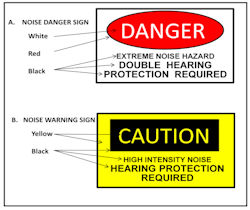Warnings
With the release of ANSI Z10-2012, "warnings" have been promoted to their own hierarchy level. Previously they were considered part of administrative controls.
However, warnings do not prevent exposure to a hazard, but they do warn people of potential danger.
Warnings can be visual, audible, tactile, or any combination of these types. Some examples of warnings are:
- Visual. Signs, labels, tags, and flashing/strobe lights.
- Audible. Alarms, bells, beepers, sirens, announcement system and horns.
- Tactile. Vibration devices or air fans.
For instance, a door could have both a sign warning of a hazard as well as an alarm if opened. Warnings can be effective deterrents, but are not as effective as elimination, substitution, or engineering controls.
A major weakness when relying on warnings as a primary hazard control method is that they may lose their effectiveness when constantly posted because employees may begin to ignore them.
Knowledge Check Choose the best answer for the question.
3-5. What is a major weakness when relying primarily on warnings as a hazard control strategy?
You forgot to answer the question!

